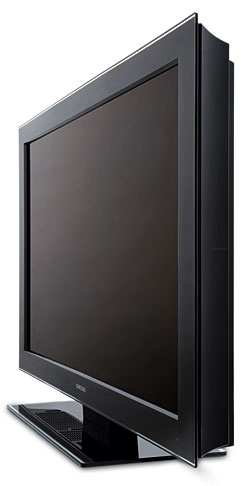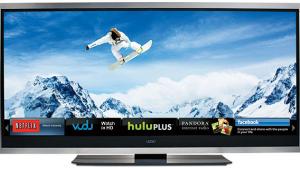Samsung LN55A950 LCD HDTV Page 2
LED Motion Plus cycles horizontal blocks of the LED backlights on and off, scroll- ing from top to bottom once every frame (120th of a second). Since this shuts off the back- lighting while the LCD is changing states from on to off, or back, you don’t see the lag that occurs during this transition. But the technique also noticeably reduces brightness.
 LED Motion Plus by itself delivered little improvement.
Auto Motion Plus 120Hz, in contrast, definitely produced smoother motion. But like all similar implementations of 120-Hz interpolation I’ve seen, it also makes film look like video. Samsung recommends using
both of its motion features together for maximum benefit. This appeared to further smooth the motion, but the film-to-video look remained. Some viewers
may find this a worthwhile tradeoff for reduced motion blur and may even like the video look. I don’t. In any case, the set’s motion lag never seriously bothered me—even with all the whiz-bang stuff turned off.
LED Motion Plus by itself delivered little improvement.
Auto Motion Plus 120Hz, in contrast, definitely produced smoother motion. But like all similar implementations of 120-Hz interpolation I’ve seen, it also makes film look like video. Samsung recommends using
both of its motion features together for maximum benefit. This appeared to further smooth the motion, but the film-to-video look remained. Some viewers
may find this a worthwhile tradeoff for reduced motion blur and may even like the video look. I don’t. In any case, the set’s motion lag never seriously bothered me—even with all the whiz-bang stuff turned off.
Dark City
With the LN55A950’s LED SmartLighting engaged in a darkened room, the screen goes totally black and disappears from view when the source fades to black. This can be a bit disconcerting (it plunges you into a dark void), but it’s still an incredible thing to see. Or rather, not see.
While Samsung claims a peak contrast ratio of 1,000,000:1 for this set, that’s not a measurement we can verify with our Minolta LS-100 light meter. But when the result is too dark to see anyway, what are a few ten-thousandths of a foot-lambert between friends?
The Samsung produces black levels and shadow detail that are superior to any other LCD I’ve tested to date. Only the Pioneer KURO plasmas can challenge it in this respect, and even the KUROs don’t go as deep into black as the LN55A950 does.
But in my initial tests with very dark scenes, the Samsung appeared to crunch some of the darkest areas into total black. The effect was roughly like watching a front-projector image when someone puts his hand between the projector and the screen and blocks part of the picture.
After a couple of days gnashing my teeth, I ran a few tests that indicated the Samsung was crushing black somewhere below a 10-percent brightness level. The exact threshold depended on where the brightness and gamma controls were set.
As it turns out, Samsung has a fix for this problem, which it has reportedly implemented in all but the earliest production samples—like ours. It involves readjustments to several service level controls. After I made those changes, the problem was nearly eliminated and only turned up on the most challenging, near-black material, such as a few scenes in Master and Commander: The Far Side of the World. Even then, it was so subtle that I probably only spotted it because I was alert to the issue. If you purchase one of the earliest sets and notice this issue, contact Samsung. We’re also passing this information on to the ISF and THX, so they can alert their trained calibrators.
I also experienced a strange anomaly with the set’s local dimming on the last day of my testing. (These things always happen on the last day of testing!) After a few hours of rechecks using white field and white window test patterns, the set developed splotches of darker areas all across the screen in a specific pattern. It looked as if several of the LED zones had become fatigued and either shut off or been dimmed. I turned the set off for 5 minutes, and when I turned it back on, they were gone. This was the only time I encountered this problem.
The LED local dimming can also produce a dim but visible halo of light around bright objects on a black background. This is inevitable when the number of LED lighting zones is limited by the need to keep the sales price within reason.
But in nearly all cases, the very darkest, low-contrast scenes were remarkably free of the gray-on-gray foggy look that compromises dark scene contrast on nearly all other LCD sets.
Images had a richness and level of shadow detail that conventional LCD sets lack. And the full-black fade-outs remained totally black. With LED SmartLighting off, the Samsung is a set with distinguished color, video processing, and resolution. But it’s in the middle of the LCD pack when it comes to blacks and shadow detail. With SmartLighting on, it’s the whole package—and one of the most impressive sets on the market.
I see I’ve used up nearly all of my allotted space discussing the Samsung’s blacks and shadow detail. No problem. This is also an exceptionally fine set in all other respects. Its color and resolution are first rate. It passed most of my video-processing checks with flying colors except with mixed video-and-film content (such as a scrolling video news text over a movie), where it performed poorly.
The best HD discs looked spectacular. Pop Seven Years in Tibet into your Blu-ray player to get an eyeful of what this set can do with the best program material. Fleshtones were natural, and greens were far less luminescent than on many other digital displays. The Samsung’s reds do look a little orange, but that’s the nature of the red color point of the HD spec. While animation isn’t a good reference standard, the color and resolution on the new Blu-ray release of Madagascar leapt off the screen. Gorgeous.
Comparisons and Conclusions
The obvious competition for the Samsung is the Pioneer Elite KURO plasma. I was unable to perform a side-by-side com-
parison of these two sets, but I have extensive experience with a number of KUROs and am very familiar with their performance. Without seeing them together, my impression is that the Pioneers and this Samsung are far closer in both black level and shadow detail than I ever would have imagined possible, and only the Samsung will give you that total fade-to-black experience. The Samsung, however, does have those subtle but real halos around bright objects on a dark background, while the Pioneer plasmas do not.
The two are also very close in subjective resolution. The Pioneer’s picture pops a little more, but the Samsung can be set to deliver a much brighter image. The Samsung’s off-axis performance is mediocre. The image starts to fade noticeably at 20 degrees or so from the center. Although it’s watchable at somewhat wider angles, I’d still fight for that center money seat to get the best picture. The Pioneers, like all plasmas, remains bright and crisp as far off axis as you choose to go. The Pioneer, like all plasmas, can develop burn-in if you don’t exercise some basic caution with stationary images; the Samsung will be immune to this. But the Pioneers have no motion-blur issues, nor any need for compensatory features that work but may have undesirable side effects. All in all, as the Brits would say (and I have no idea what it means), horses for courses.
The Samsung LN55A950 is an exceptional set, with superb, color, fine resolution, and compelling black levels and shadow detail that competing LCDs can only dream of—at least until they get on the local dimming express. If you’re in the market for a flat-panel LCD and your budget allows, don’t choose another set until you have a chance to see this one.




























































